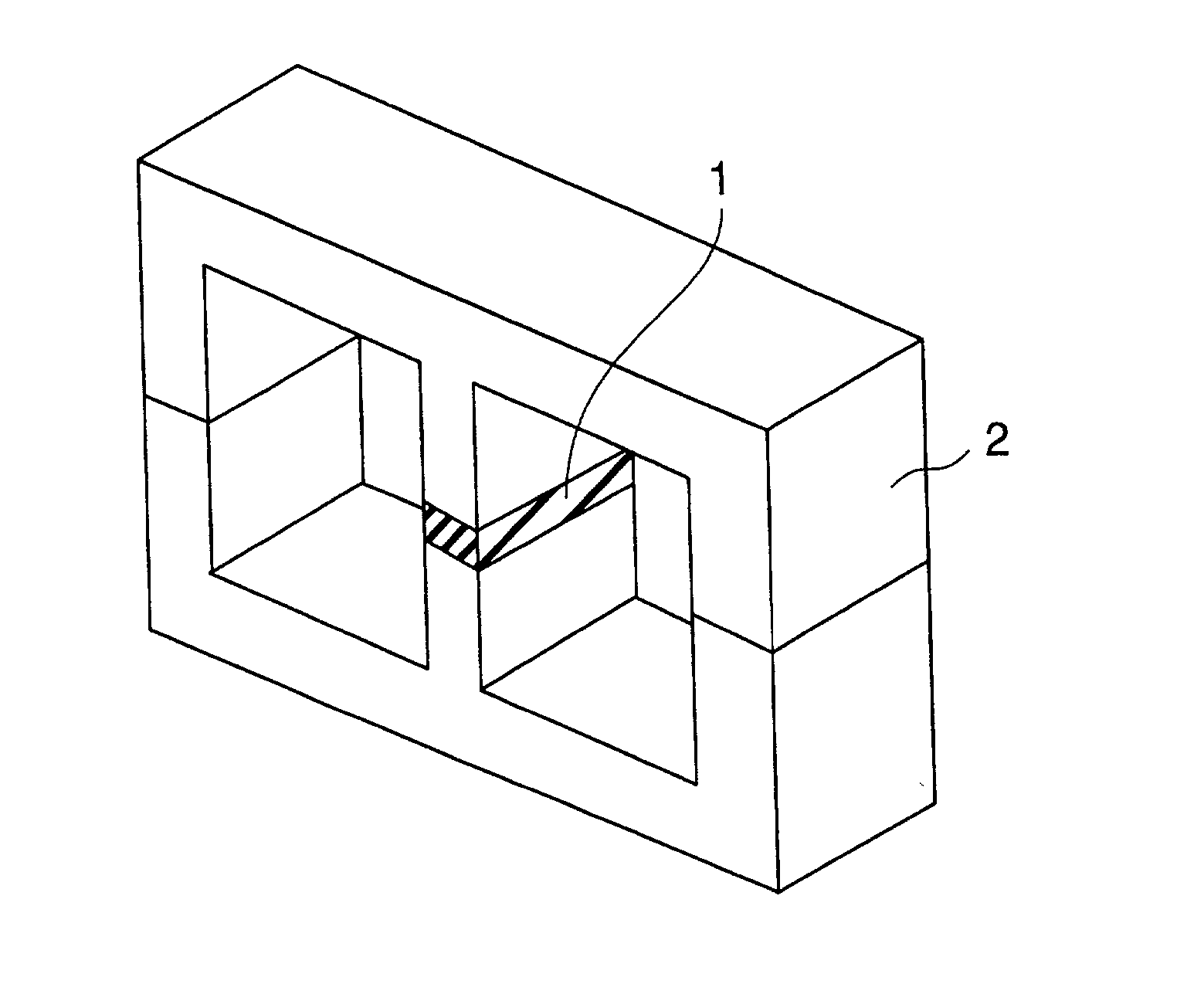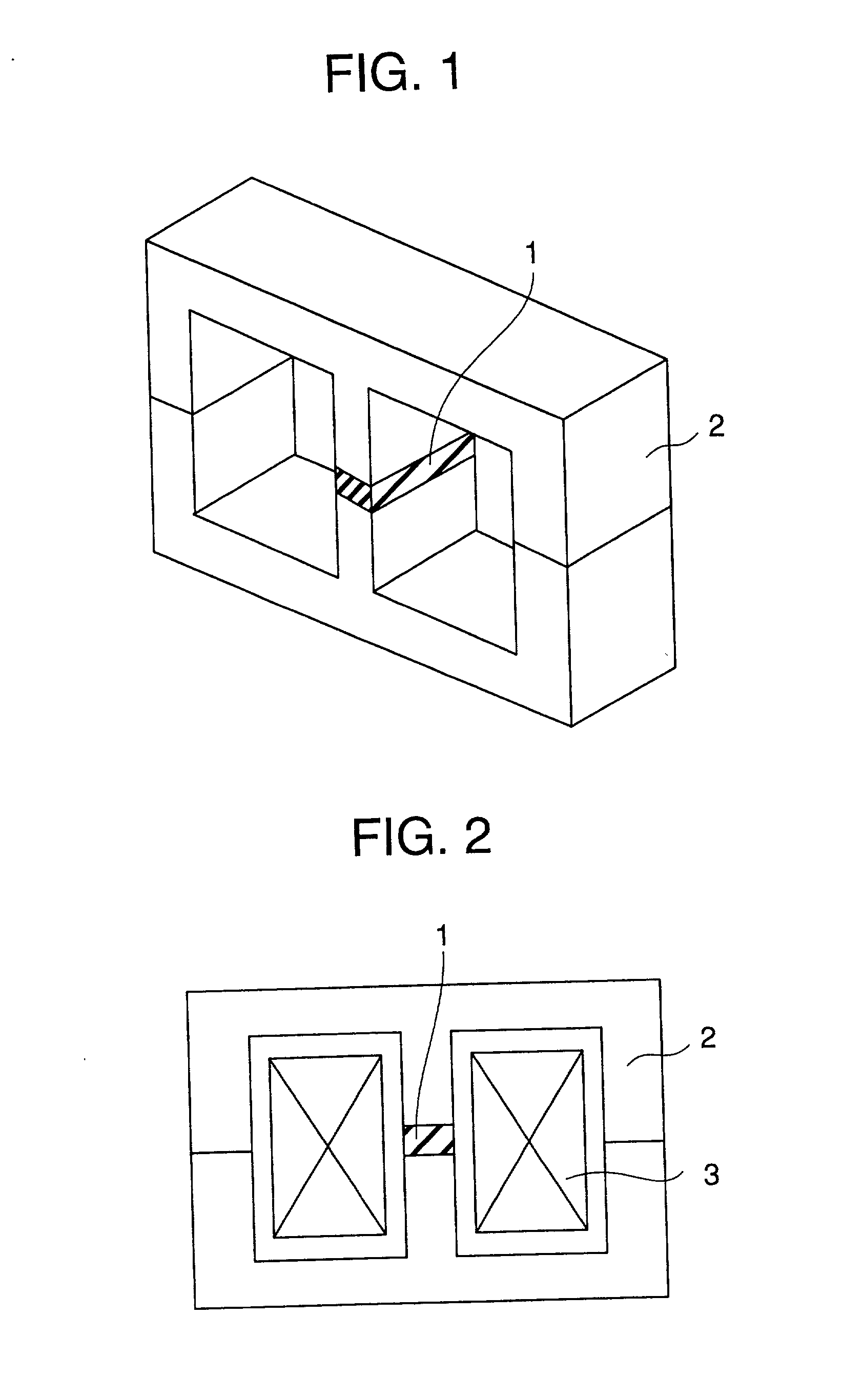Magnetically biasing bond magnet for improving DC superposition characteristics of magnetic coil
a magnetic coil and superposition characteristic technology, applied in the direction of magnets, transformers/inductances magnetic cores, magnetic bodies, etc., can solve the problems of difficult to determine good and bad of magnetic cores for choke coils and transformers by core temperature measuremen
- Summary
- Abstract
- Description
- Claims
- Application Information
AI Technical Summary
Benefits of technology
Problems solved by technology
Method used
Image
Examples
example 1
Relation Between Specific Resistance and Core-loss
[0137]
1 Magnetic powder: Sm.sub.2Fe.sub.17N.sub.3 Average particle size: 3 .mu.m Intrinsic coercive force iHc: 10.5 kOe Curie point Tc: 470.degree. C. Binder: Epoxy resin Amount (volume %): Adjusted to obtain following specific resistances Production method of Magnet: Molding, without aligning magnetic field Magnet: Thickness T: 1.5 mm Shape and Area: corresponding to the section of a middle leg of E-shape core Specific resistance (.OMEGA. .multidot. cm): S-1: 0.01 S-2: 0.1 S-3: 1 S-4: 10 S-5: 100 Intrinsic coercive force: 5 kOe or more Magnetization: Electromagnet Magnetic core: E-E core (FIGS. 1 and 2), MnZn ferrite Magnetic gap length G: 1.5 mm Measurement of Core-loss: Measured at f = 100 kHz, Ha = 0.1 T (Tesla) Measurement of DC superposition characteristics (magnetic permeability .mu.): Measured at f = 100 kHz, Hm = 100 Oe
[0138] The same magnetic core is used for each of samples and the core-loss measured in each sample is show...
example 2
Relation Between Particle Size of Magnetic Powder and Core-loss
[0141]
3 Magnetic powder: Sm.sub.2Co.sub.17 Curie point Tc: 810.degree. C. Energy Product: 28MGOe S-1: Maximum particle size: 200 .mu.m Intrinsic coercive force iHc: 12 kOe S-2: Maximum particle size: 175 .mu.m Intrinsic coercive force iHc: 12 kOe S-3: Maximum particle size: 150 .mu.m Intrinsic coercive force iHc: 12 kOe S-4: Maximum particle size: 100 .mu.m Intrinsic coercive force iHc: 12 kOe S-5: Maximum particle size: 50 .mu.m Intrinsic coercive force iHc: 11 kOe Binder: Epoxy resin Resin content: 10 weight % in each sample Production method of Magnet: Molding, without aligning magnetic field Magnetization: Electromagnet Magnet: Thickness T: 0.5 mm Shape and Area: 7 mm .times. 10 mm Specific resistance: S-1: 1.2 .OMEGA. .multidot. cm S-2: 1.5 .OMEGA. .multidot. cm S-3: 2.0 .OMEGA. .multidot. cm S-4: 3.0 .OMEGA. .multidot. cm S-5: 5.0 .OMEGA. .multidot. cm Intrinsic coercive force: Same as magnetic powder Magnetic core...
example 3
Relation Between Coercive Force of Magnet and DC Superposition Characteristics (Magnetic Permeability)
[0145]
5 Magnetic powder: S-1: Ba ferrite Intrinsic coercive force iHc: 4.0 kOe Curie point Tc: 450.degree. C. S-2: Sm.sub.2Fe.sub.17N.sub.3 Intrinsic coercive force iHc: 5.0 kOe Curie point Tc: 470.degree. C. S-3: Sm.sub.2Co.sub.17 Intrinsic coercive force iHc: 10.0 kOe Curie point Tc: 810.degree. C. Particle size (Average): 3.0 .mu.m in all samples Binder: Polypropylene resin (Softening point 80.degree. C.) in each sample Amount: 50 volume % Production method of Magnet: Molding, without aligning magnetic field Magnet: Thickness T: 1.5 mm Sectional shape: corresponding to the section of a middle leg of the core Specific resistance: S-1: 10.sup.4.OMEGA. .multidot. cm or more S-2: 10.sup.3.OMEGA. .multidot. cm or more S-3: 10.sup.3.OMEGA. .multidot. cm or more Intrinsic coercive force: Same as magnetic powder Magnetization: Pulse magnetization machine Magnetic core: E-E core (FIGS. 1 ...
PUM
| Property | Measurement | Unit |
|---|---|---|
| particle size | aaaaa | aaaaa |
| Curie point Tc | aaaaa | aaaaa |
| particle size | aaaaa | aaaaa |
Abstract
Description
Claims
Application Information
 Login to View More
Login to View More - R&D
- Intellectual Property
- Life Sciences
- Materials
- Tech Scout
- Unparalleled Data Quality
- Higher Quality Content
- 60% Fewer Hallucinations
Browse by: Latest US Patents, China's latest patents, Technical Efficacy Thesaurus, Application Domain, Technology Topic, Popular Technical Reports.
© 2025 PatSnap. All rights reserved.Legal|Privacy policy|Modern Slavery Act Transparency Statement|Sitemap|About US| Contact US: help@patsnap.com



